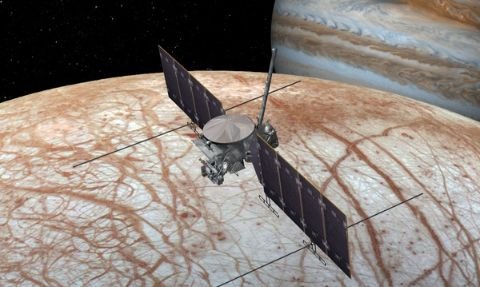Future Planetary Probes Can Learn from Cassini

An unusual water composition at Saturn’s moon Phoebe means that future spacecraft will have to be on the lookout for different water ratios than we are used to on Earth.

This composite image of Saturn’s moon Phoebe was by the Cassini spacecraft on June 11, 2004.
NASA / JPL-Caltech
A moon of Saturn has water that literally is out of this world, showing once again that the design of future spacecraft will need to be flexible in searching for water and life.
Using a new method of measuring abundances of isotopes, scientists have found an unusual ratio of deuterium to hydrogen (D/H) in water at the Saturnian moon Phoebe. Deuterium is an isotope of hydrogen — whereas hydrogen has just one proton, deuterium has one neutron as well.
The results, based on data from the Cassini spacecraft’s Visual and Infrared Mapping Spectrometer (VIMS), show that while Saturn’s rings and most of its moons have D/H ratios similar to Earth, the moon Phoebe is way out of whack, displaying a ratio that is higher than any other known object in the solar system. The implication is that Phoebe might have formed in a different region than Saturn’s neighborhood. Since models suggest that D/H ratios skew higher in the farther reaches of the solar system, Phoebe might have originated well beyond Saturn and then migrated to its current home.
While the Cassini find is astonishing in itself, it also shows the need for having adaptable instruments on future spacecraft that will look at water in solar system bodies. A prime example is Europa Clipper, which is expected to fly to Jupiter’s moon Europa in the 2020s, as long as NASA funding lasts long enough to see it through the construction and launch phases.
Clipper will carry the Mapping Imaging Spectrometer for Europa (MISE) instrument — an imaging spectrometer with better resolution than Cassini’s VIMS. The instrument will examine Europa’s surface to see if it could support life, searching for key amino acids such as leucine, which is involved in the biosynthesis of proteins. It will also seek out organic materials, altered silicates, and other compounds that are relevant to astrobiology investigations. MISE co-investigator Roger Clark (Planetary Science Institute), who also led the Phoebe study published November 29th in Icarus, says Clipper should be able to make similar finds to Cassini when measuring the D/H ratio at Europa.

NASA’s planned Europa Clipper mission sails over the icy surface of Jupiter’s moon Europa in this illustration.
NASA
“Clipper has the instrumentation needed to make the measurements,” says Clark in an e-mail. “We do, however, need to do lab work to calibrate the deuterium signatures for the compounds that are on Europa, including acids and salts.” Clark says that MISE will not need any design changes in light of Cassini’s new find.
The gradient in D/H measurements in planets and moons as one moves farther out into the solar system does have an interesting implication for Clipper, says mantle geochemist William Minarik (McGill University), who clarifies that he teaches students about stable isotopes and icy moons, but does not consider himself an expert in the field.
Measurements so far of various moons suggest that their individual D/H ratios are determined by what kinds of smaller bodies — comets and asteroids — smashed together and coalesced into these larger bodies, “reflecting the chaos of the late stages of the formation of the solar system,” he says in an e-mail.
The big takeaway is that the way a particular moon forms depends on where its material came from. Clipper’s measurements of the isotopic composition of Jupiter’s icy moons — either by reflectance spectroscopy of several moons, or by direct measurements of Europa material — may help answer this question, says Minarik.
“The major moons of Jupiter likely formed at the same place in the nebula as Jupiter, and interior to Saturn,” he says. “A value of D/H between that of the asteroids and the moons of Saturn would solidify the trend.” Although it may be that each moon has a unique formation history, he adds.
Parts of the answer as to whether Phoebe is unique and how the D/H ratios of different objects in the solar system compare may also come from other missions, Minarik says. The Hayabusa 2 and Osiris-REX missions are each studying water-bearing asteroids and aim to return samples to Earth, where researchers will examine the oxygen, nitrogen, and hydrogen isotopes. Additionally, the James Webb Space Telescope, scheduled to launch in 2021, has instruments capable of D/H measurements and is already scheduled to observe Europa and Enceladus in near- and mid-range infrared wavelengths, he says.
Reference:
R. N. Clark et a. “Isotopic Ratios of Saturn’s Rings and Satellites: Implications for the Origin of Water and Phoebe.” Icarus. November 29, 2018.

